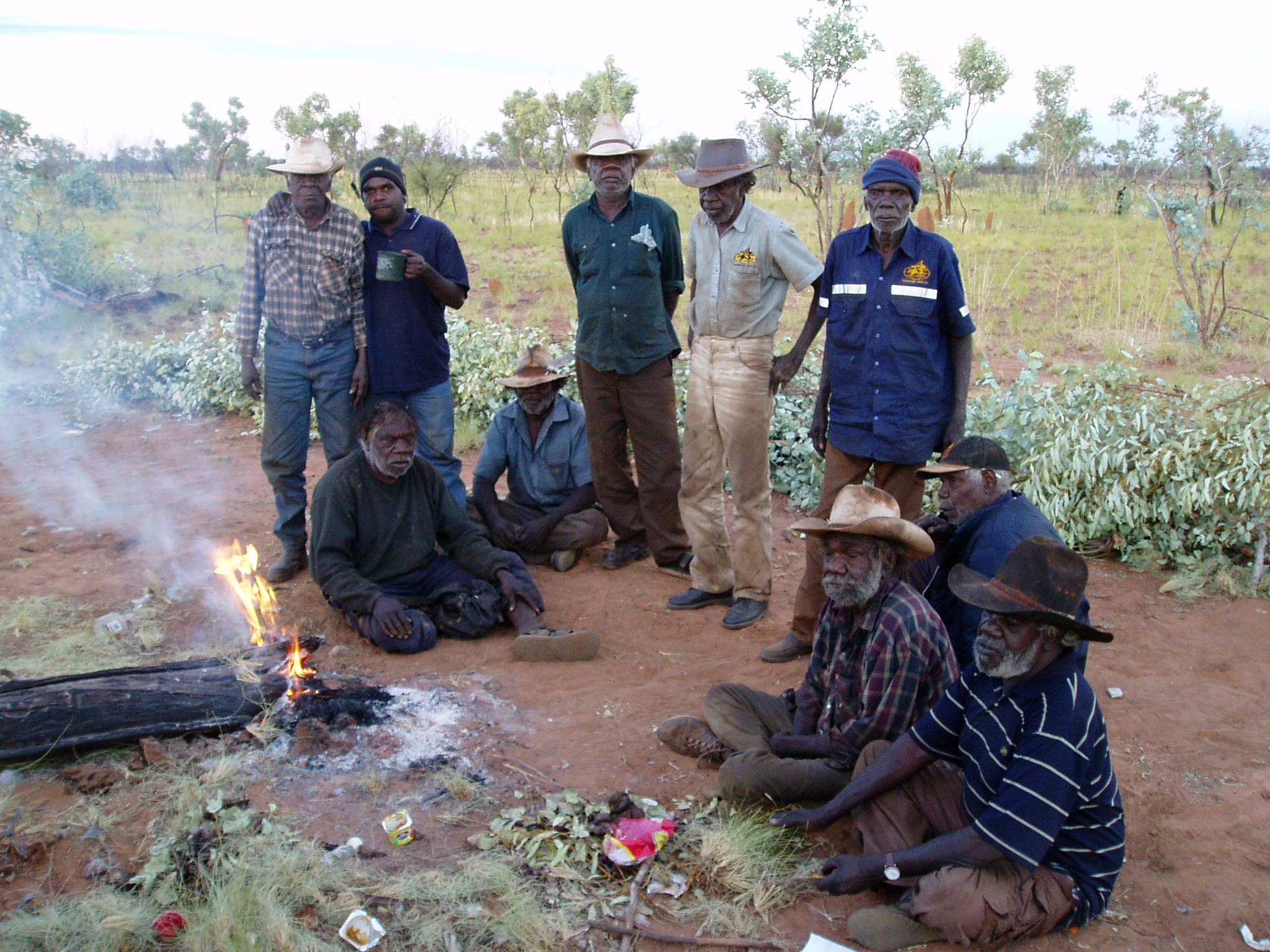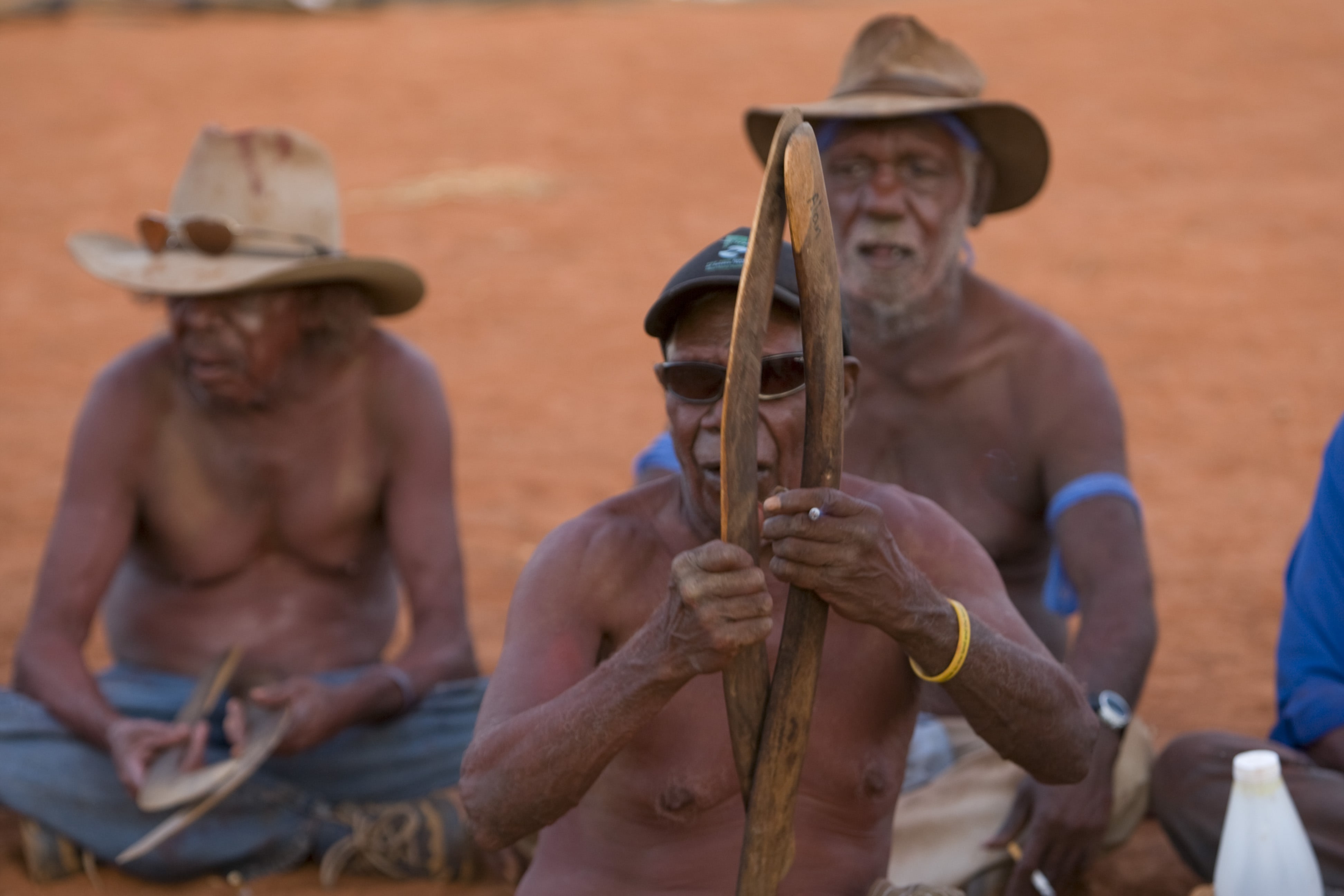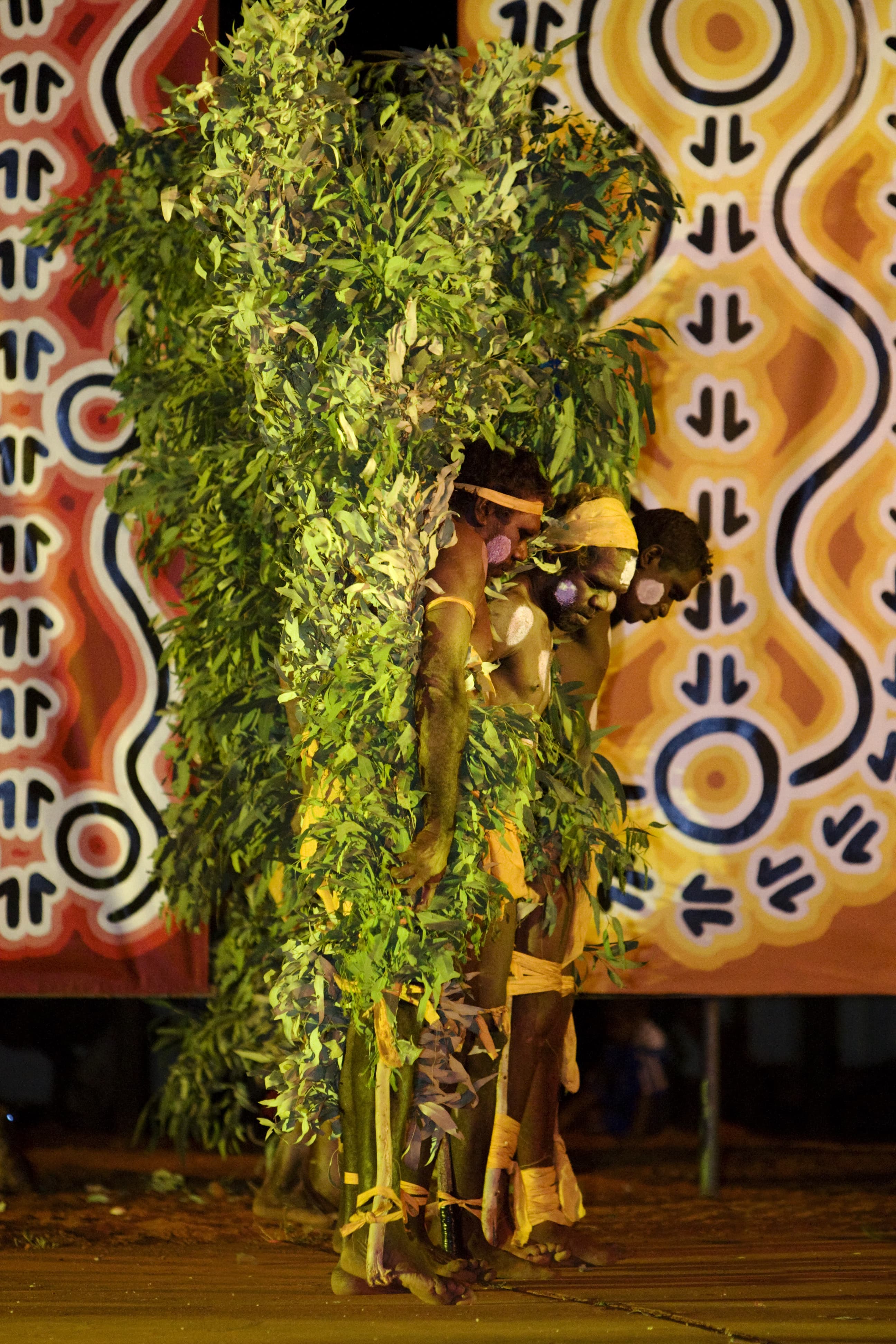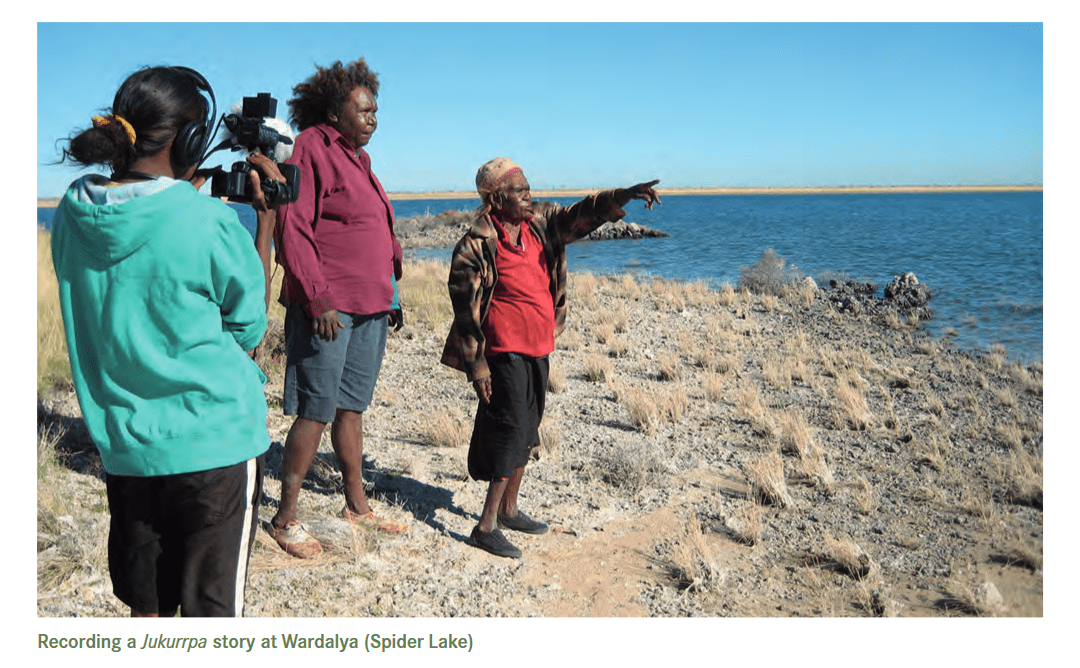Milpirri Banner - MALAJILA - (Rufous hare-wallaby)
Dreaming
Mala (Rufous hare-wallaby). This design shows the mala tracks around the outside and up the centre. The curved lines are the tail of the mala. Malajila is a key mala site. Elders in Lajamanu suggested that one of the circles is Malajila and the other is Spider Lakes called Warralya or Wurralya in Warlpiri. This is where the mala dreaming finished its travels.
Warralya on Google earth, one of the places represented by a circle on this banner - Map
Belonging to Skin Groups
Japaljarri, Jungarrayi, Napaljarri and Nungarrayi (Yellow Group)
Place
Chilla Well. The Warlpiri dictionary states that: “Mala Dreaming is associated with Japaljarri-Jungarrayi section, with water sources such as Mawurrungu, Kalykaji, Kapuka and Wurralya.”
See Chilla Well - Map
Latin
Lagorchestes hirsutus
Biology
Mala (Rufous hare-wallaby) - Photos / Information
Drawn By
Dick Japaljarri Raymond in Lajamanu 2005
Artist Profile
Born at Yartulu-yartulu (the Granites) c. 1936, Dick’s language and tribe are Warlpiri. Dick lives at Lajamanu. His country is Chilla Well and his main dreamings are are Mala (wallaby) and Janganpa (possum). He also paints a Ngatijirri (budgerigar) story for the site of Wirliyajarrayi where the budgerigar ancestors emerged, travelling on through Jila. A version of this Dreaming was purchased for the National Gallery of Victoria’s collection and shown in Mythscapes Melbourne in 1989. In 1983 Japaljarri was one of 12 Warlpiri male leaders from Lajamanu who travelled to Paris to make a ground painting for the exhibition “D'un autre continent: l'Australie la reve et le reel” at ARC/Musee d'Art Moderne de la Ville de Paris. Japaljarri began to paint in 1986 when a traditional painting course was set up in the Adult Education Centre at Lajamanu. Dick is known as a master craftsman, lawman and expert singer of traditional songs. He has a good knowledge of country, and was a regular participant on country visits, and sacred site survey work prior to having a stroke several years ago.
12 Warlpiri men who travelled to Paris in 1983 to perform the Jurntu ceremony - Maurice (Morris) Luther Jupurrula, Ronnie Jakamarra Lawson, singing Jurntu Purlapa with other Warlpiri men dancing: Thomas Sampson Jangala, Dick Japaljarri Raymond, Jimmy Robertson Jampijinpa, Abie Jangala, Joe Long Jangala, Thomas Jangala Samson, Bobby Payton Japaljarri and Bob Leo Japaljarri. The image is from BG’s archive - Photo
Dick Japaljarri Raymond's work within the National Gallery of Victoria collection - Photo / Information
Dick Japaljarri Raymond's biography from the National Gallery of Victoria - Story
Dick Japaljarri Raymond's biography from Design and Art Australia Online - Story
Family
In Lajamanu, to learn more about Malajila, ask Richard Japaljarri Payton or Biddy Nungarrayi Long.
Kurdunglurlu
Nampijinpa, Jampijinpa, Nangala and Jangala skins groups, in Lajamanu Leslie Jampijinpa Robertson is a Kurdungurlu.
Warlpiri Traditional Knowledge
Mala in kuyu yumurru-kurlu, Jalangu-jalangu manu nyurru-warnu (Meat animals with fur that we eat today and used to eat in the past) by Ormay Nangala Gallagher. BRDU, Yuendumu School Yuendumu, N.T. (2014) - Photo / Story
Language Stories
Mala ka palkaju nyinami marlu-piya-juku-jala. Kala ngayi witalku ka nyinami malaju.
Mala has a body just like that of a plains kangaroo, except that the Rufous Hare-wallaby is smaller.
Marnangkalpanyanu pangurnu ngurra malangku. Nyinajalpa yalirla. Ngulakurralparnalu panturnu, kapilparnalu karlirlangurlu luwarnu malaju.
The mala digs its home in the spinifex. It sits there and we used to spear it right there. Also we used to strike it with a boomerang, for example.
Kilji-nyayirni ka parnkami malaju.
The mala runs very fast.
Mala kalalu panu lirri-nyinaja manangkarrarla walypali-wangurla-wiyi. Jalangu kalu wirrkardulku nyina.
There used to be a lot of mala before the Whites came. Now there are only a few of them left.
Mala, rdipirri, kala jintajuku yangka yirdi yika nyina mala manu rdipirriji - kala nyurnungkaju marda kajikalu ngarrirni - Mala-jukurrparla manu Rdipirri-jukurrparla 'Wangkungawurrpa'lku. Wangkungawurrpa kajikalu ngarrirni. Nyurnungkaju. Kala - Wampana-jukurrpa yangka kajilpa yapa paliyarla, Yulkaminyi-jukurrpa, ngula kajikalu ngarrirni marda wangkungawurrpayijala.
Mala and rdipirri, they are names for the same thing. If someone dies who is called Mala-jukurrpa or Rdipirri-jukurrpa (Rufous Hare-wallaby-dreaming), then they would call the animal wangku-ngawurrpa (nest-dweller). They would call it wangku-ngawurrpa if someone died. And if some person called Wampana-jukurrpa or Yulkaminyi-jukurrpa (Spectacled Hare wallaby-dreaming) were to die then they would call that animal wangku-ngawurrpa (nest-dweller) as well.
Dictionary Source: Laughren, M., K. L. Hale, and Warlpiri Lexicology Group, 2005 Warlpiri-English Encyclopaedic Dictionary. (Accessed Via Kirrkirr Interface to Electronic Files.) University of Queensland
Further Reading
Mala songs sung for conflict resolution ceremonies
From: Georgia Curran (2010) Contemporary Ritual Practice in an Aboriginal Settlement: the Warlpiri Kurdiji Ceremony. PhD University of Sydney, P.96-97
“Peterson (1970) has glossed these ceremonies as ‘fire ceremonies’ or ‘conflict resolution ceremonies’. These ceremonies involve large-scale participation of many people who are often required to come from remote places. It is this focus on participation of many people cooperating which makes it useful in conflict resolution. The song series which are sung by men for these ceremonies are all linked to Jukurrpa stories which involve an initial fight which is resolved through joint performances of ceremonies (Rice 2007: pers.comm).
Four of the ceremonies have been described by Dussart, these being Ngajakula, Jardiwanpa, Puluwanti and Kura-kurra. Dussart has shown that there is an obligatory reversal and exchange of roles in performance from one associated series to the next (Dussart 2000: 79). Peterson enhances this description demonstrating that there are complex interrelationships amongst these ceremonies, emphasising that Ngajakula and Jardiwanpa relate to different patrimoieties. The two patricouples within each of these moieties relate more directly to certain Dreamings along these lines. Jardiwanpa belongs to Jakamarra/Jupurrurla/Jangala and Jampijinpa patrimoiety. The Dreaming ancestor yarripiri (python) begins his travels at Wirnparrku, this place and associated Dreaming belonging to the Jakamarra/Jupurrurla patricouple. Further along this journey, the yankirri (emu) Dreaming joins in with the travels belonging to Jangala/ Jampijinpa patricouple. Other Dreamings such as wampana and ngurlu (Nakamarra/Napurrurla) also join in at various points.
See the Wampana Milpirri Banner - Photos / Information
Ngajakula revolves around the journey of mala (rat kangaroo) from Mawurrungu associated with the Japaljarri/Jungarrayi patricouple. Intimately linked is the journey of Puluwanti (owl) which is associated with the country surrounding Willowra. This belongs to the Japangardi/Japanangka patricouple. Laughren (2009: pers.comm) and Peterson (2009: pers.comm) have both independently reflected that in the 1970s when they lived in Yuendumu Ngajakula was performed more often than Jardiwanpa as the eastern Warlpiri from Willowra were dominant in ceremonial activity. Nowadays, Jardiwanpa is the most popular of the two ceremonies with many Warlpiri people using Jardiwanpa as a general gloss for these conflict resolution ceremonies which are performed almost identically despite their links to different Dreamings and country. Jardiwanpa has been performed several times over the last few decades whereas Ngajakula has not been performed at Yuendumu since the 1970s.”
See the Waringarri (owl) Milpirri Banner - Photos / Information






